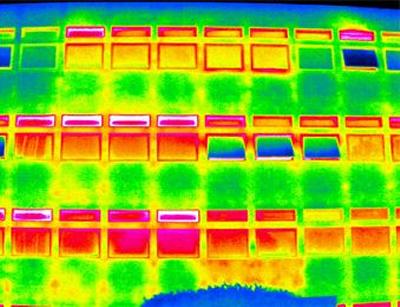Even if opening a window has a limited impact on the environmental conditions in an office, it is often a desirable feature as users are typically more tolerant as they feel they have been able to take action to improve their space. The ability of a user to interact with a façade does not, however, come without risk to the energy performance of a building. In a domestic setting, a householder is directly responsible for the energy bills and would therefore not consciously leave a window open overnight in the winter. In an office environment however, there is no financial driver for the user to operate the façade in the same energy efficient manner. Whilst there may be a strong driver to open a window in an office (stuffiness, high temperature), the driver to close the window (energy awareness) may be very weak unless there is an additional driver such as external noise, rain or a security risk. This poses a real challenge to the facilities manager, ‘happy productive users’ prefer control of the façade, which is what well designed non-domestic building environments should provide, but providing this control introduces significant energy performance risk.

This study proposes to develop and test a low cost, non-invasive technique to assess the impact of poor facade control on energy performance and enable facilities managers to address this issue. We are looking to use external cameras to diagnose the status of a facade in terms of window opening, blind and internal lighting usage and to engage the Facilities Manager, security staff and building users to change the facade state. This approach can help address issues of (1) winter heating losses, (2) summer overheating and (3) poor internal lighting operation. Whilst security guards may provide an effective solution to the problem of energy waste, successful users’ behavioural change in managing windows and blinds is very important in non-domestic buildings where there are no guards or where guards cannot intervene due to their narrow remit.
All interventions will be developed through a user-centred design approach. Workshops will be conducted at the start of the project, to make sure that the interventions fit both with the technical constraints and with the organisational culture of the buildings where they will be deployed. In particular we will focus on (1) the trade-offs between preserving privacy and sharing information and (2) on the balance between group-level and individual feedback. As far as point (1) is concerned, a privacy-preserving intervention would allow us to send email messages to individuals who left their windows open, in the hope that this will not be done in the future. In contrast, broadcasting to everyone on a given floor in which windows are currently open and need closing would allow users to take action here and now. This second approach may be considered more constructive (rather than reprimand), it would require everyone to know which windows were left open, and by inference who might have left them so. Regarding point (2), our aim is to test whether the effect of individual feedback (e.g. individual emails saying “you left your window open last weekend”) can be reinforced by framing it in the context of the general performance of people occupying the same building (e.g. through a public display or an email that is sent to everyone).
Designing interfaces and systems which provide and maintain user engagement is the other key theme of this study. Decay in user engagement is a challenge for any behaviour change intervention and often not fully addressed in studies. Here we anticipate strong and sustained engagement with the facilities manager and security staff who are the primary path to energy savings in the building. Engagement with users of buildings such as offices is far more challenging where developed interfaces have to add value to the individual to ensure their sustained use beyond the initial ‘novelty / honeymoon’ period.
Key references:
(2018) The effect of behavioural interventions on energy conservation in naturally ventilated offices, Energy Economics 74, p. 582-591, The Author(s), url, doi:10.1016/j.eneco.2018.07.008
(2018) Camera-based window-opening estimation in a naturally ventilated office, Building Research and Information 46(2), p. 148-163, doi:10.1080/09613218.2016.1245951
